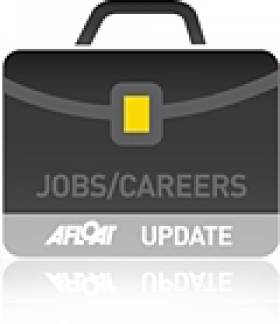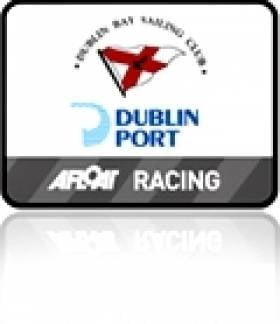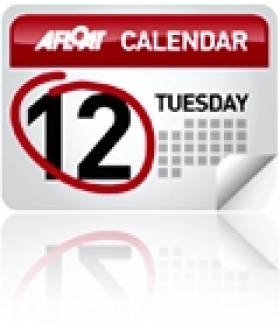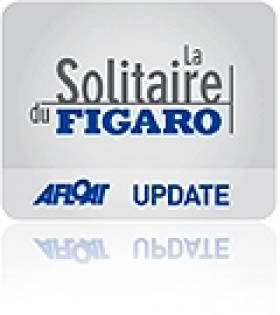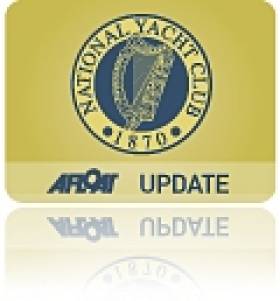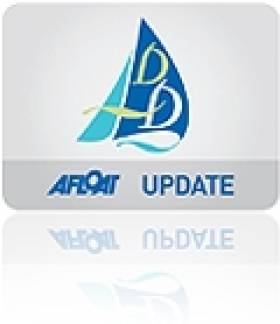Displaying items by tag: National
Model Yacht Racing Series Underway in Dun Laoghaire
#MODEL YACHTS – Dun Laoghaire's Winter Model Yacht RC Laser sailing programme got off to an enthusiastic if somewhat wet start on the Bank Holiday Monday. The impromptu gathering was intended to dust off the cobwebs but instead proved a test of the waterproofing of all the equipment because of the very heavy rain.
Nonetheless 7 boats turned up, including some new ones and the usual faces were seen at the front of the fleet in the trying conditions with the new boys coming to grips with getting the best out of their boats.
With over 20 boat owners in Dun Laoghaire and 3 new owners this year, there is renewed enthusiasm evident so come along and enjoy the fun. Organisers say you do not have to be a member of the Nationall Yacht Club to participate.
The class now has excellent marks, an automatic tannoy starting system and access to a super mark laying and rescue boat.
From next week on the RC Laser class shall be meeting every Sunday in the National with racing planned to commence at 2pm with at least 10 races being organised. Racing will be in front of the Club or from the East Pier near the Bandstand.
A new recording system for results and a league system will be running which will be divided between the period up to Christmas and January/February in 2012.
National Maritime College Open its Doors
Situated on the shores of Cork Harbour this magnificent facility has both a National and International reputation with students from as far away as the United Arab Emirates. For the Open Day, representatives from International Shipping Companies and Maritime Organisations will be available on site to provide information about careers in the industry.
There will be tours of the College, including the multi-million euro shipping simulators, sea survival centre and engineering workshops.
Details on course opportunities at the NMCI will be available at the Open Day – Tuesday, October 25th. For further information please contact phone 021 4970607
New 'Ensign' Class Takes off for Dublin Bay Sailing Club
Tomorrow is the penultimate race of the DBSC season, a season in which the 350-boat club tackled the long standing problem of crew shortages. Together with Dun Laoghaire's waterfront yacht clubs, DBSC introduced an 'Ensign Class' to extend the possibility of bay racing to a greater of people.
Up to 1,500 sailors race each Thursday and Saturday during the Summer but typically cruiser classes, which represent the bulk of the fleet, always run short of crew. A typical 30 foot boat can require a crew pool of 15 or more.
People with no experience are now being taken afloat in a cosseted fashion by the club and introduced to the rudiments of sailing.
The idea has proved so successful the National Yacht Club now operates a waiting list for its club 1720 sports boats, the Ensign class of choice.
The hope is that racing skippers, who rarely want complete novices onboard but who are nevertheless short of crew, will be encouraged to pick from those graduating from the Ensigns.
DBSC's Hon-Sec Donal O'Sullivan says the pilot project looks set to continue into the winter for the popular Turkey Shoot Series.
Dun Laoghaire Yacht Clubs Voice Concern Over Plan
Dun Laoghaire Yacht Clubs are voicing concerns about the impact on sailing if a 'cruise ship jetty' is constructed as part of the recently published harbour masterplan.
Dublin Bay Sailing Club, Dun Laoghaire Motor Yacht Club, National Yacht Club, Royal Alfred Yacht Club
Royal Irish Yacht Club and Royal St George Yacht Club. are also concerned about access to the water if a proposed 'pedestrian walkway' in front of the waterfront clubs was completed.
The clubs have engaged 'professional help' to prepare a submission to outine the concerns.
Also seen as a problem is the 'lack of sufficient facilities in the masterplan for hosting significant international sailing events'.
A survey in 2009 by the Irish Marine Federation (IMF) calculated a €3million spend by participants connected with the 500-boat Volvo Dun Laoghaire regatta. The clubs have previously stated they see the harbour's future as a leisure facility.
A masterplan model was on display by the Harbour Company in the month of August.
Writing to members in the current edition of the National Yacht Club's newsletter commodore Paul Barrington says the clubs 'hope to further engage with the harbour [company] to find a mutually acceptable way forward'.
Water Rat: Harbour Plan is a Curate's Egg
Lift out Scheduled for October 15th
Cork and Strangford Sailors to the Fore at Topper World Finals
The 173 strong fleet of youth sailors at the Sovereign Ski Topper World Championships produced some surprises on the first day of the finals on Dublin Bay. Having dominated the qualifying series this week, Matt Venables of Sutton YC (UK) found himself edged out somewhat in the Gold fleet, managing two 4ths in the first two finals.

Toppers prepare for a race start. More photos from Gareth Craig on the gallery here.
Ireland's Patrick Crosbie (RCYC) grabbed the first win of the day, just ahead of Laura Gilmore of Northern Ireland, with Gilmore winning race 2 ahead of Britain's Danielle Rowe. It was a strong performance from young Crosbie, named by the ISA earlier this year as Ireland's most promising youth sailor, in his first year of racing toppers.
Newcastle's Joe Henderson dominated in the Silver Fleet finals, taking two strong wins. "I got good starts and played the tide", said the 13year old with ambitions to become a round-the-world racer, adding "it was a nice wind, with light chop but not too much hiking". Once again the girls performed strongly, with Britain's Samantha Foster and Ireland's Alison Dolan both taking 2nd places.
In Bronze fleet Conrad Parkinson of Northern Ireland really upset the form book, having sprung from a best of 22nd in this week's qualifiers to score victories in both of todays races. Ireland's Thomas Moore scored two seconds, with Patrick Butler nabbing a third in the first race. The happy face of Youngwan Kim said it all, as he took a third for Korea in race 2, clearly none the worse for jet lag!
After waiting 2 hours for a sea breeze to settle in, Principle Race Officer Con Murphy ran three races for gold, and two each for silver and bronze in a steady 10kts of wind. "we expect light airs and rain tomorrow for the second day of the finals" said Murphy, adding strong winds are expected on Friday, giving testing conditions to these young sailors. Day 3 Results here.
Below event photos by Michael Chester.
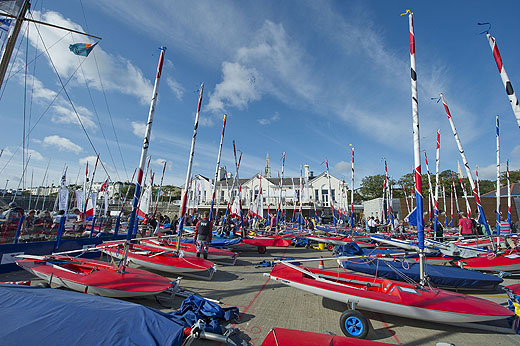
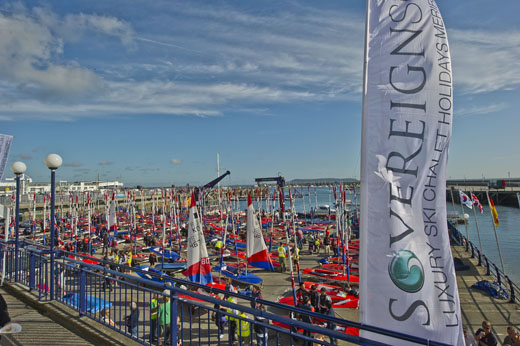
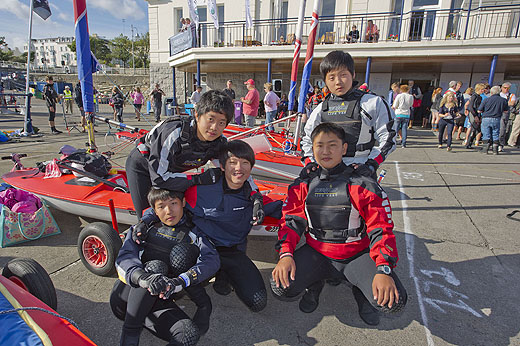


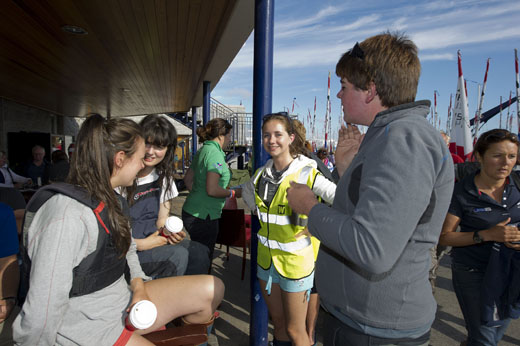

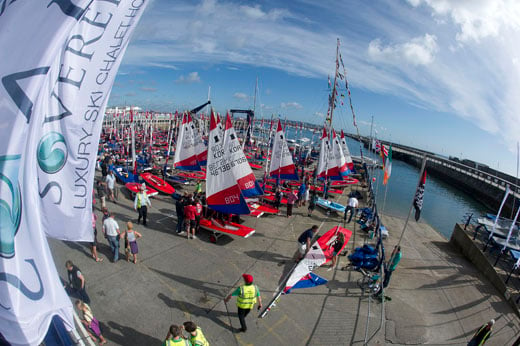
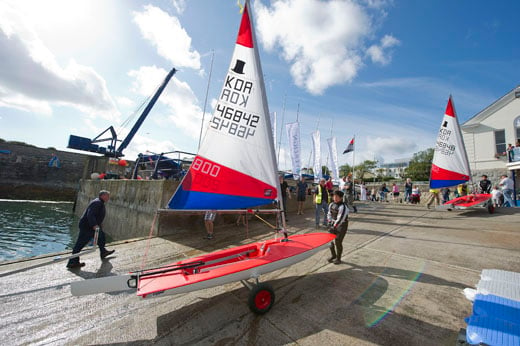
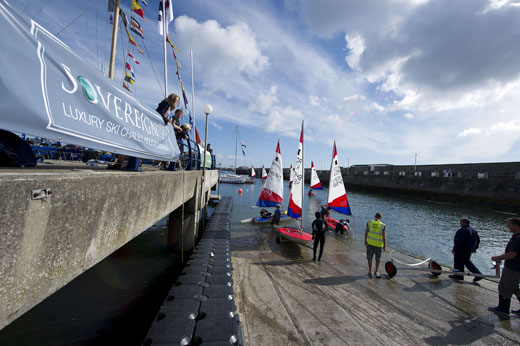
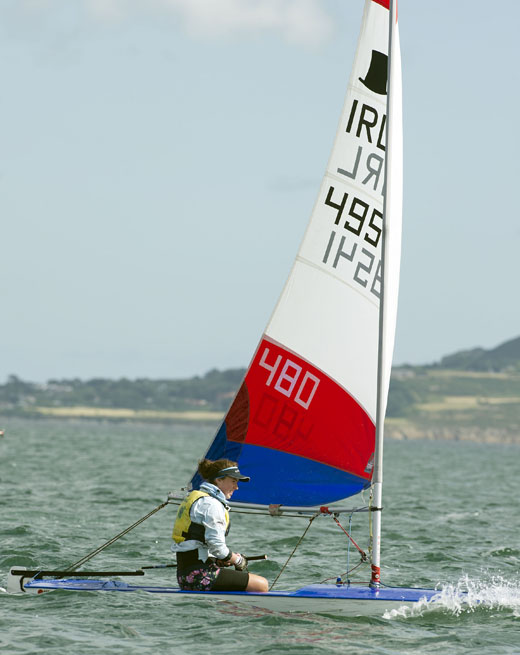
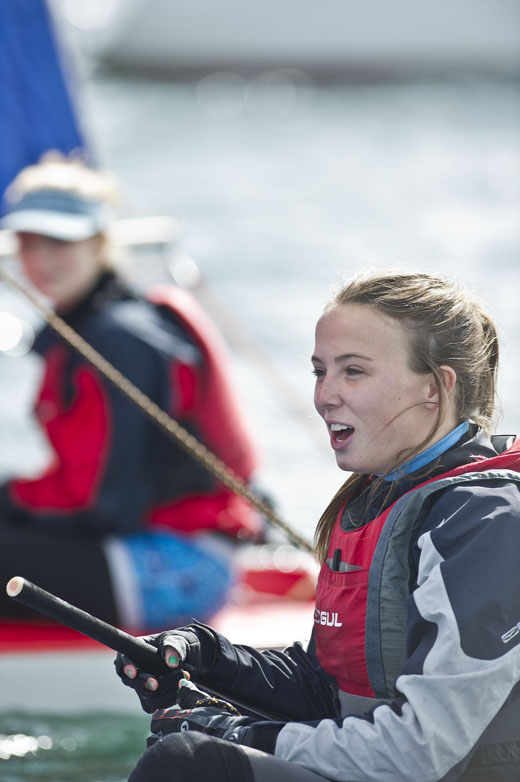


Dun Laoghaire Plan is a Curate's Egg
When a property doesn't have as many redeeming features as the developer would like, extra effort is put into talking it up by way of the promotional brochure. It could be said that the gloss of the brochure takes the place of the gloss of the property. It is to be earnestly hoped that this isn't the case with the Dun Laoghaire Harbour Company's Consultation Masterplan. While a fine example of the graphic designer's craft, once the observer has penetrated the overly complex web presentation, the content is closer to the curate's egg – a mixture of good and, well, not so good.
The introduction to the plan does a fine job of setting the context, although the author loses some of the high ground by suggesting that Dun Laoghaire is "one of the most beautiful man-made harbours in the world".
The masterplan does recover from this and the other floral verbosity of the opening statements to identify the crucial roles played by marine leisure interests and the town of Dun Laoghaire in the sustainable development of the harbour. The plan regularly refers to the need for careful design to promote greater interaction between town and harbour, an area of failure of past administrations on both sides of the railway tracks.
In the detail, it is interesting to note that the plan shies away somewhat from the flawed concept, mooted in previous versions, that Dun Laoghaire can become a cruise liner port. This is clearly a non-runner in the short to medium term as there is very little to commend Dun Laoghaire over its larger, deeper and more commercially inclined foster parent to the north.
Another area that seems to be set up for failure is the idea that the Harbour Company, in their own words "custodians of this valuable national asset", could contemplate the private ownership of areas of the harbour through property development.
The plan hints at improved access for the watersports constituency, but a serious flaw is the lack of a stronger stance on establishing a safe, wide, non-tidally restricted slipway with easy access to open water, something that does not exist in greater Dublin area outside of the yacht clubs. Such a facility, with the appropriate management, could be self funding.
And in the pie-in-the-sky category is the suggestion of placing a public baths on the inside of the East Pier, a proposal that requires the reclamation of valuable sheltered water.
The plan refers extensively to the diaspora project, but outside of the masterplan itself, this idea has not caught the imagination. It does refer to a maritime element in the project, but does not see this as mainstream. This is a pity, because moving the National Maritime Museum 100 metres from its current location could provide Dun Laoghaire with the iconic attraction it needs to start making it a destination in its own right, changing from its traditional role as a bi-directional gateway. A museum project on the Carlisle Pier, with the potential for floating exhibits alongside, could bring in excess of 1/4 million visitors each year.
The plan refers to similar developments in Leith, near Edinburgh, where former royal yacht Britannia is moored, but curiously neglects to mention Falmouth, where a town of some 22,000 people attracts a similar number to its recently constructed maritime museum. And neither Leith nor Falmouth enjoy the considerable transport network, both marine and land based, that makes Dun Laoghaire so easy to get to.
Comment on this story below
Figaro Fleet Inches Forward to Dun Laoghaire
The race stops in Dun Laoghaire Ireland from August 12th, the only foreig stop over of the circuit.
Thomas Rouxel (Bretagne Crédit Mutuel Performance), moves into the lead ahead of his two closest rivals, Nicolas Lunven (Generali) and Jérémy Beyou (BPI), in what has been a cat and mouse game for the pole position since yesterday's start. Britain's Phil Sharp (Spirit of Independence) punches his way up to 6th place overall and leads the rookies on their first Solitaire race. What remains to be seen is if the light easterly thermal breeze will hold up for the sailors as they battle against the strong tidal current to get round the Fairways mark for the Southerly course back across the Channel to Caen.
The light conditions for Sunday morning's start gave way to moderate southerly breeze to allow the 47 competitors a Channel crossing towards Plymouth and the Hands Deep course mark under spinnaker in relatively good 7 to 8 knots pace. The fleet then made the most of the favourable tide on the run along the South coast of England, where the sailors each chose how best to negotiate rounding the various headlands and associated current on course for the Fairways. The wind gradually died out this afternoon just off Anvil point ,12 miles from the turning point, leaving the skippers the choice of either attempting to fight their way against the 3 knots of tidal current and dying breeze or dropping anchor to sit it out until the tide turns.
The leaders (Rouxel, Lunven, Beyou) on the direct heading are followed by a group made up of Eric Drouglazet (Luisina), Fred Duthil (Sepalumic), Erwan Tabarly (Nacarat) and rookie sailor, Phil Sharp (Spirit of Independence). Further north, a breakaway group looking for the shelter of Poole Harbour and hoping for a thermal breeze to propel them round the Fairways and into the favourable current is made up of Laurent Pellecuer (Atelier d'architecture JP Monier), Frédéric Rivet (Vendée 1), Morgan Lagravière (Vendée), Charlie Dalin (Keopsys) and Jean-Pierre Nicols (Bernard Controls). If their gamble does not pay off, they could pay with a costly time deficit on the leaders. Others have opted for more southerly and offshore course in the hope that a veering wind could provide a good angle of approach to the mark, but for now Thierry Chabagny (Gedimat), Etienne Svilarich (Volkswagen Think Blue) and Alexis Loison (Port Chantereyne-Cherbourg-Octeville) can just hope as they see themselves fall back on the position reports.
The situation is not so clear for the sailors, led by Michel Bothuon (Les recycleurs bretons), who have not passed Anvil Point, where the tidal effects are strong. Sam Goodchild (Artemis), Francisco Lobato (ROFF) and Nigel King (E-Line Orthodontics) caught up in this bunch can only hope that the leaders are forced to drop anchor to reduce the distance.
Phil Sharp (Spirit of Independence) from Jersey has made an astounding climb over the course of the last 24 hours, having started in the bottom half of the fleet, he is now well positioned 1.1 miles behind the leading trio in 6th place overall behind Erwan Tabarly (Nacarat) and is currently heading the rookie rankings. Phil has gradually progressed and moved his way up the fleet opting for a more offshore course just south of the rhumb line and is well placed to round the Fairways mark, just 5 miles away at 15:30. Devon's Conrad Humphreys (DMS) stays within reach of the leaders at just 2.2 miles in 18th place.
British skipper, Sam Goodchild (Artemis), enjoyed a brilliant start in Perros Guirec on Sunday, to round the first course mark in 7th place, holding on the the race leaders throughout the day. This morning the Race Committee reported that Sam had torn his spinnaker, which would explain the loss of ground on the lead and his current 41st place and 9.4 mile deficit on the leaders.
Weather conditions have been better than anticipated since Sunday's start in Perros Guirec, allowing for the solo sailors to keep up a pace that could see them arriving into Caen from Tuesday afternoon.
Skipper's quotes over the VHF today:
Eric Drouglazet (Luisina):"We could well be anchored about ten miles from the Fairway buoy. I did not sleep all that much last night, so have not sailed all that badly. The leading boats are going to get round the next mark with the favourable current, but for those left behind it is only get to get worse and worse..."
Paul Meilhat (Macif 2011): "This is a beautiful leg with a lots of chances. And there will be more to come! It's a bit like having a fresh start, this passage from Portland Bill.We had light conditions and everyone came back from behind. I am very happy right now and everything is going well...I have good boat speed. I have been playing it bit by bit and think I'll try to continue with this strategy. I'm in shorts and a T-shirt: it's very nice after night in the drizzle. But there will be another difficult night. As soon as the thermal wind is going drops we are just going to come to a standstill..."
Gildas Morvan (Cercle Vert): "It was not all that great at the start. Then I managed to get back by sailing well up to Hand Deeps. Overnight got in too close to shore. It was not a good idea trying to go in close round Start Point. Now, I have come back a pit on round Portland Bill further out. For now we have 8 knots from the West, but it is is going to drop and it is going t be really very painful getting the turning tide at the Needles!"
Thomas Rouxel (Bretagne Crédit Mutuel Performance): "There is a real battle going on with the three of us, Jérémy Beyou, Nicolas Lunven and myself. All is going well but it is not over yet! We are making slow progress with the wind we have, but from 14:00 onwards we should have the current against us to deal with too. I think that it is going to be complicated and a whole lot of things could happen..."
Isabelle Joschke (Galettes Saint Michel): "For me, I see that there has been a turnaround. The first group was caught in the calm. A large group came back on this leader group. We are all under spinnaker, the wind is getting up in the bright sunshine and flat seas: it's very nice. The first night is always difficult to rest. I had a few naps and I ate well. It's hard to let go of the pressure because we are all in contact. I'll try to go take a nap now that the wind is established and before it once again becomes complicated. We will find ourselves facing the current to get passed the Isle of Wight. If we are forced to anchor, where I am, there a 30 metres of depth... It will not be very nice!"
Morgan Lagravière (Vendée):"I had a good first 24 hours and then about two hours ago mucked up the getting passed the transition area which needed special care and managed to loose quite a few places. Not easy to decide on which position to take but I am feeling good in terms of keeping up the pace. I am annoyed with myself and so will have to work out my anger and climb my way back up the fleet."
Official opening of the Race Village in Caen at 17:00 local time
The official opening of the village of La Solitaire du Figaro Eric Bompard Cashmere in Caen will be held at 17:00 in the presence of Philippe Duron, Mayor of Caen and president of the Urban Community Caen la mer, Laurent Beauvais, President of the Region lower Normandy and Jean-Léonce Dupont, Chairman of the General Council of Calvados.
Diane II Races to Ruffian Success on Dublin Bay
Taking the Ruffian prize at Volvo Dun Laoghaire Regatta two weeks ago, Class vice-captain Alan Claffey sailing Diane II added the national title yesterday after a three day series on Dublin Bay. SCROLL DOWN FOR PHOTOS BY GARETH CRAIG.
The championship, hosted by the National Yacht Club, was sailed in light airs, and featured 20 boats, including three boats from Carrickfergus and two from Skerries.
After 2 days, "Carrigeen" from Carrickfergus was leading Diane II by 2 points, but Claffey took two guns on the final day to clinch the championship.
Carrigeen was second and Siamsa from Skerries was third.
Overall Results for the 2011 Dun Laoghaire to Dingle Race
| Yacht name | Skipper | Club | ||
|---|---|---|---|---|
| Two-Handed | 1st | Dinah | Barry Hurley | RIYC |
| Cruiser Class | 1st | Spindrift | David Kelly | Wicklow Hbr SC |
| 2nd | Yahtzee | Richard Mossop | Calafort Sea Scouts | |
| 3rd | Persistance | Jerry Collins | RStGYC | |
| Ocean Blue | Frank Cassidy | NYC | ||
| Mojito | Peter Dunlop | Pwlhelli SC | ||
| Racing Class | 1st | Galway Harbour | Martin Breen | Galway Bay SC |
| 2nd | Raging Bull | Matthew Davis | Skerries SC | |
| 3rd | Tsunami | Peter Ryan | NYC | |
| Aquelina | James Tyrrell | Arklow SC | ||
| Jedi | Andrew Sarratt | RStGYC/RIYC | ||
| Sailing West Intuition | Paul Adamson | NYC | ||
| Sgrech | Stephen Tudor | Pwlhelli SC | ||
| Legally Brunette | Cathal Drohan | RStGYC | ||
| English Mick | Carol Payne | Poolbeg Y&BC | ||
| Pride of Dalkey Fuji | Alam McGettigan | RIYC | ||
| Lula Belle | Liam Coyne | NYC | ||






























